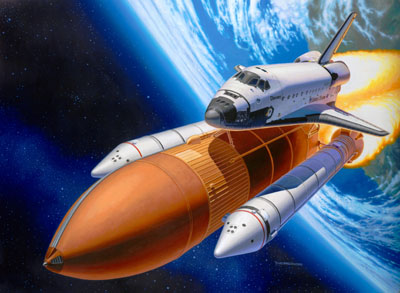Law Of Conservation of Momentum
The basic principle that all rockets work by is law of conservation of momentum that is the total momentum of two objects before collision is equal to the total momentum of the two objects after collision that is the momentum lost by object 1 is equal to the momentum gained by object two.
In case of rocket science the rocket launches itself by ejecting
some of its mass downwards. In fact while a rocket is being accelerated upwards
its engine is continuously ejecting some mass and forcing it downwards. Because
this mass is forced downwards, by conservation of momentum the rocket must then
be forced upwards. In terms of forces the rocket has to exert some force on the
ejected mass to push it downwards which then results in an equal and opposite
reaction force pushing the rocket. Greater is the momentum, more is the thrust
developed. That is how law of conservation of momentum or Newton’s third law of
motion is responsible for launching of rocket.
Types of Propulsion System
There are only two types of propulsion system which can get
a rocket escape the earth’s atmosphere. They are i.) Liquid Propellant Rocket Engine ii.)Solid Propellant Rocket Engine
In this article we will understand about how a liquid
propellant rocket engine works.
Inside the rocket engine we have the combustion chamber, the
throat and the nozzle. Inside the combustion chamber the fuel and the oxidizer
mix. The liquid fuel before entering the combustion chamber travels through the
nozzle body as it helps to reduce nozzle cover temperature and also covers some
energy savings. To pump the fuel and the oxidizer in adequate rate, two pumps
are used. These pumps are driven by a turbine which is connected to the same
shaft as the pumps. The pump turbine unit is referred to as turbo pump. A gas
generator produces hot gas to rotate the turbine. The gas generator uses
bypassed fuel and bypassed oxidizer for the purpose of combustion. Exhaust from
the turbine is mixed with main rocket exhaust.
Even as the liquid fuel converts into gas, the mass of the
fuel remain the same. The massive acceleration of this transformation from
liquid to gas causes the momentum. The mathematical representation of this
energy transformation is E=MV2
(m=mass of gas, v=velocity of gas) which implies faster is the velocity of the
gases more is the energy released. Lighter is the fuel better is it as lighter
fuels can move faster. Hence the engine uses the mass and the velocity of the
fuel as it burns to create thrust.
For example heavier but slower fuel mixture like kerosene
and liquid oxygen won’t give as much energy as mixture of liquid hydrogen and
liquid oxygen. The engine’s efficiency can increase by adjusting the hydrogen
and oxygen ratio by making it more hydrogen rich. So we conclude that if we can
take a really light fuel moving at very high velocity, we end up creating more
efficient rockets
To make it to the exosphere (space)
The fuel and the oxidizer required for the rocket engine are
stored in two large tanks. During lift off the thrust produced by the main
engine may not be sufficient so usually a few solid propellant strap boosters
are used to assist the lift off. The solid propellant strap boosters get burned
off rapidly so to reduce the weight they are abandoned after the burn off. Now
the next engine takes the charge. This way the rocket’s weight is greatly
reduced. Hence great acceleration can be achieved. This process is called
staging.
After the rocket has reached the desired height the rocket’s
nozzle is slightly tilted by high precision devices. Hence the rocket will turn
to the desired angle. After the angle is made the nozzle comes back to its
original position. Now the second engine is ignited to give the rocket enough inertia to reach its desired destination.
Liquid Propellant Engines have high specific thrust where thrust can be controlled and can be restarted.













0 comments:
Post a Comment